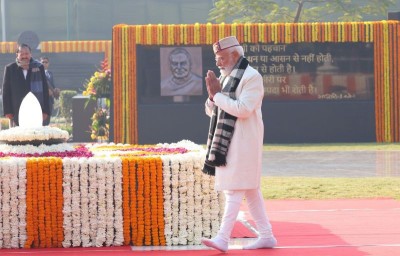 Chhattisgarh
Chhattisgarh
Chhattisgarh: Narayanpur: Unbridled Distress
On October 8, 2021, an Indo Tibetan Border Police (ITBP) trooper was injured after Communist Party of India-Maoist (CPI-Maoist) cadres fired at him in Kohkameta village in Narayanpur District. Sundarraj Pattilingam, Inspector General of Police (IGP), Bastar Range, disclosed that the incident took place at around 3 pm [IST] when the trooper belonging to ITBP's 53rd battalion was on duty at the mobile check post in front his unit's camp in Kohkameta village.
On September 23, 2021, CPI-Maoist cadres of the ‘Aamdai area committee’ (Maoist committee operating in Aamdai Ghati in Chhotedongar village) of the CPI-Maoist allegedly killed a supervisor and set ablaze four vehicles at a road construction site at Madhonar village in Narayanpur Tehsil (revenue sub-division) under Chhotedongar Police Station limits in Narayanpur District. Around two dozen Maoists thrashed the labourers at the construction site before setting ablaze a Joseph Cyril Bamford (JCB) machine, two tractors and two motorcycles there. The deceased supervisor, identified as Sandip Bajan, belonged to a village near the construction site. A Maoist pamphlet was found at the spot in which the Maoists have warned villagers to stay away from development activities. Under the Pradhan Mantri Gram Sadak Yojna (PMGSY) scheme, an approximately 10-kilometres-long road is being laid from Chhotedongar village to Madhonar village, both in the Narayanpur District.
On August 20, 2021, two ITBP personnel, including an assistant commandant, were killed in a CPI-Maoist attack near Kademeta camp of 45th Battalion of the ITBP under Chhotedongar Police Station limits in Narayanpur District. A squad of the ITBP's 45th battalion, which was out on an area domination operation, was fired upon by a small action team of the Maoists, when it was approximately 600 metres away from the camp in which two ITBP personnel were killed. Maoists also looted and escaped with one AK-47 rifle, two bullet-proof jackets and one wireless set of the security personnel.
According to partial data collated by the South Asia Terrorism Portal (SATP), at least five civilians and 11 Security Force (SF) personnel have been killed in Narayanpur District thus far in 2021 (data till October 10). During the corresponding period in 2020, one civilian and one SF trooper had been killed; a total of three fatalities (one civilian and two SF personnel) were recorded through 2020. Significantly, since May 11, 2007, when Narayanpur was carved out from the erstwhile Bastar District, a total of 31 civilians and 78 SF personnel fatalities were recorded in the district. 113 Maoists have also been killed.
The number of civilians killed in the current year has jumped from one to five, highest number of civilians killed in a year since May 11, 2007 when the district was formed. Equal number of civilians were killed in 2007 and 2010 as well. Clearly, an indication of deteriorating security situation.
And it is not surprising, given the fact the number of SFs killed jumped from two in 2020 to 11 in 2021. The SF:Maoist kill ratio of 5.5:1 in the current year favors the Maoists, for the first time since 2010, when the SF:Maoist kill ratio was recorded at 2.7:1.
Narayanpur, one of Chhattisgarh’s 32 Districts, is surrounded with dense forests, hills, streams, waterfalls, natural caves, and a forest cover of 2116.915 square kilometres which accounts for 32.87 per cent of the District’s total area of 6,640 square kilometres. Narayanpur District is divided into two administrative blocks: 1) Narayanpur, having 45 Gram Panchayats (village level local self-Government institutions) with 176 villages (172 inhabited), is spread over an area of 2760 square kilometers, and 2) Orchha, having 24 Gram Panchayats with 237 villages (209 inhabited), is spread over an area of 3880 square kilometers. Orchha comprises the Abujhmaad region, the unsurveyed zone in central India and home to Primitive Tribal Group Madia Gond and Muriya Gond. The difficult terrain and natural protection offer Narayanpur an immense ‘geo-strategic importance’ for the Maoists, and has long served as a major transit route for the rebels to cross into the Naxalite [Left Wing Extremist, LWE] affected areas of the neighbouring States, giving them safe passage to orchestrate violence on both sides of the State borders. Reportedly, Narayanpur abuts Bijapur and Dantewada Districts in the south; Bastar in the East; Kanker District in the North; and the Gadchiroli District of Maharashtra in the west. Moreover, being a part of the troubled ‘Bastar Division’ of Chhattisgarh, and the large presence of Naxalite insurgents, security situation has been a major concern for people who live here.
Undeniably, a December 20, 2020, report revealed that the Maoist’s ‘liberated’ area, as of now, ranges from 3,000 to 10,000 square kilometers, mostly in the Narayanpur, Bijapur and Sukma Districts. Of these areas, around 3,000 square kilometers is totally out of the control of the Government, while the rest of the area has varying degrees of control; for example, food and medicines can go in, teachers can go in, but the forest department and Police etc. can’t.
On June 15, 2021, IGP, Bastar Range, Sundarraj Pattilingam thus disclosed;
In east Bastar region, they (the Maoists) have become almost non-existent while security forces have established complete dominance in North Bastar and Darbha valley area today by opening security camps. South Bastar, including Sukma-Bijapur districts, and west Bastar - especially Narayanpur district - are important regions for them. Abujhmaad or simply Maar area in Narayanpur is a safe hideout or shelter home for them. This is also an important source of economy and logistic support for Naxals though their activities are mainly focused in the southern part.
Sukma, Deputy Superintendent of Police, K. L. Dhruv noted,
So far, they had free run in this area… they use it for their movements from south to west Bastar, mainly towards Abujhmaad forest area in Narayanpur district bordering Maharashtra. Abujhmaad is their base station and source of livelihood for them.
Further, on September 26, 2021, an unnamed senior official, who attended the meeting of LWE-affected States held in New Delhi, commenting on the issue of "security vacuum" in the areas of Chhattisgarh bordering Gadchiroli (Maharashtra) and Gondia (Maharashtra), thus stated,
A large chunk of area in Bijapur and Narayanpur districts across Gadchiroli has virtually no police presence or government outreach. This has created a security vacuum, which has proved to be a hindrance not only in inter-state anti-Naxal operations but has also helped Naxalites chased by Maharashtra police run away to the safe haven in Chhattisgarh.
Agreeing on the security situation, another State official from the neighbouring Maharashtra, also thus said;
The Naxalites enjoy a virtual sanctuary of up to an average of 30-40 km [kilometres] depth in the Abujhmaad area of Bijapur and Narayanpur adjoining Gadchiroli. This problem is peculiar to the Maharashtra-Chhattisgarh border. It doesn't exist when it comes to Chhattisgarh-Odisha and Odisha-Telangana, where large deployment of security forces has been done due to the greater severity of LWE problem. The state has raised this issue at the meeting as the Maharashtra-Chhattisgarh border problem has remained unattended.
Moreover, on October 3, 2021, Chhattisgarh Chief Minister Bhupesh Baghel said Naxalite activities in Bastar region are now confined to Bijapur and Narayanpur.
Not surprisingly, Narayanpur, along with six other Districts (Bastar, Bijapur, Dantewada, Kanker, Rajnandgaon and Sukma) of Chhattisgarh, is listed among the ‘25 Most Affected (LWE) Districts’ in eight States of the country. Further, Narayanpur is covered under the Security Related Expenditure (SRE) scheme for conducting focused operations against the ultras to contain the menace, along with 13 Districts (Balrampur, Bastar, Bijapur, Dantewada, Dhamtari, Gariyaband, Kanker, Kondagaon, Mahasamund, Rajnandgaon, Sukma, Kabirdham and Mungeli) of the State.
The Maoists fighting tough battle in the rest of the country are enjoying a free run in their inaccessible stronghold areas of Abujhmaad in Narayanpur and other affected regions in Chhattisgarh. However, effective and time-bound implementation of the development projects, along with continuing SF pressure on the rebels, will certainly corrode the Maoist heartland areas and thwart their incipient design.
Support Our Journalism
We cannot do without you.. your contribution supports unbiased journalism
IBNS is not driven by any ism- not wokeism, not racism, not skewed secularism, not hyper right-wing or left liberal ideals, nor by any hardline religious beliefs or hyper nationalism. We want to serve you good old objective news, as they are. We do not judge or preach. We let people decide for themselves. We only try to present factual and well-sourced news.







